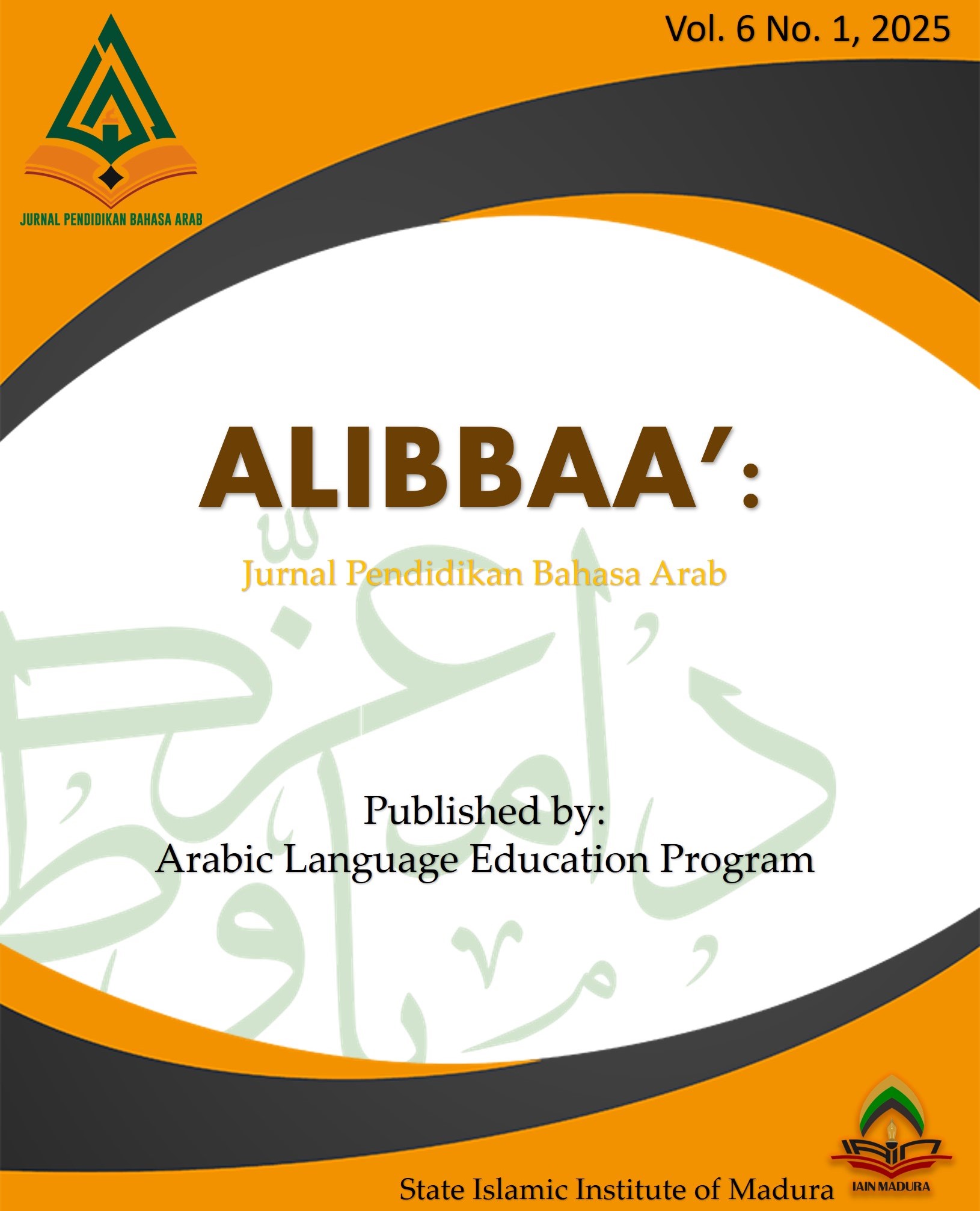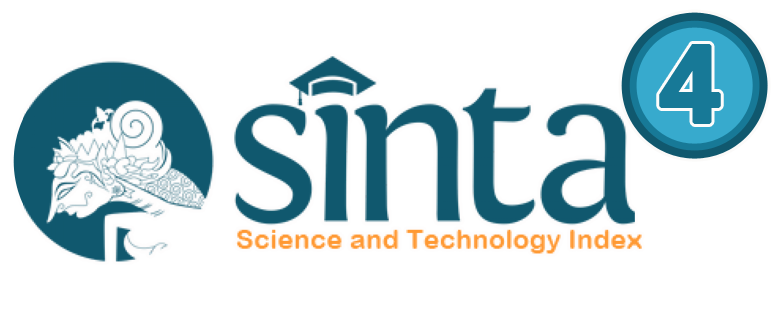Tathwîr al-Rusûm al-Hazliyyah al-Raqmiyyah 'alâ Tathbîq Canva li Ta'lîmi Mahârati al-Qirâah Ladâ Thullâbi al-Madrasati al-Ibtidâiyyah al-Islâmiyyah bi Indonesia
 Abstract views: 60
,
Abstract views: 60
,
 pdf downloads: 80
pdf downloads: 80
Abstract
This research aims to develop digital comics using the Canva application to teach reading skills, assess their validity, and analyze students’ interests and responses. The study employed the ADDIE model of research and development, consisting of analysis, design, development, implementation, and evaluation stages. Data were gathered through observations, interviews, and validation questionnaires from experts and students and analyzed using percentages and a Likert scale. Results showed that the educational medium was highly effective, receiving scores of 87.6% from subject experts and 84% from media experts, categorized as "very good." Students' responses also indicated a high level of interest, with a score of 85%, classified as "very good." These findings demonstrate that developing digital comics via the Canva application is a valid and effective solution for enhancing students' reading interest and improving their comprehension of reading materials.
Downloads
References
Abdelkader, Mahmoud Helal. “The Effect of Using Language Learning Strategies in Teaching Arabic on the Development of Some Language Skills of Primary School Students” 7, no. 16 (2023).
Ahmad, N.A. (2019). Using interactive media to support reading skills among underachieving children. International Journal of Innovation, Creativity and Change, 8(7), 81-88, ISSN 2201-1315, https://www.scopus.com/inward/record.uri?partnerID=HzOxMe3b&scp=85077449195&origin=inward
Albro, J. (2019). Six Key Principles: Bridging Students’ Career Dreams and Literacy Standards. Reading Teacher, 73(2), 161-172, ISSN 0034-0561, https://doi.org/10.1002/trtr.1823
Anh, La Nguyet, and Tran Thi Hanh Phoung. “Overview Research on Reading Comprehension Skills in Teaching Reading Comprehension of Texts in High Schools.” International Journal of Education and Social Science Research 6, no. 1 (2023): 89–106.
Aryani, Kadek Ayu, Ni Luh Putu Elly Ardani, Ni Made Candra Kurnia Dewi, Ni Made Alit Arisandi, Ni Luh Dina Adriani, and Basilius Redan Werang. “Analisis Faktor Penyebab Rendahnya Minat Literasi Siswa Di Sekolah Dasar.” Jurnal Ilmiah Multidisiplin 3, no. 03 (2024): 75–79. https://doi.org/10.56127/jukim.v3i03.1320.
Aulia, D, F Firman, and D Desyandri. “Pengaruh Multimedia Interaktif Berbasis Canva Terhadap Kemampuan Membaca Permulaan Siswa Sekolah Dasar.” Alpen: Jurnal Pendidikan Dasar, 2023. http://alpen.web.id/index.php/alpen/article/view/181.
Catelly, Y.M. (2019). Innovative technology in the language class-learning by laughing, with memes under focus. eLearning and Software for Education Conference, 39-48, ISSN 2066-026X, https://doi.org/10.12753/2066-026X-19-074
Butarbutar, R. “Learner’s Perception of Task Difficulties in Technology-Mediated Task-Based Language Teaching.” Englisia: Journal of Language, Education, and …, 2021. https://jurnal.ar-raniry.ac.id/index.php/englisia/article/view/10079.
Chong, S W, and H Reinders. “Technology-Mediated Task-Based Language Teaching: A Qualitative Research Synthesis.” Language Learning and Technology, 2020. https://www.research.ed.ac.uk/en/publications/technology-mediated-task-based-language-teaching-a-qualitative-re.
Conard, S. (2019). Best practices in digital health literacy. International Journal of Cardiology, 292, 277-279, ISSN 0167-5273, https://doi.org/10.1016/j.ijcard.2019.05.070
Hidayatillah, Baiq Wahyu Diniyati, and Abdian Akbar Atiq. “Nilai-Nilai Pendidikan Karakter Dalam Buku Teks Muthala’ah Dan Implikasinya Dalam Pembelajaran Maharah Qiraah.” Alibbaa’: Jurnal Pendidikan Bahasa Arab 4, no. 2 (2023): 225–48. https://doi.org/10.19105/ajpba.v4i2.8798.
Dirawan, G D, D D Andayani, and ... “Peningkatan Literasi Digital Pada Santri Pesantren Syeh Hasan Yamani Memanfaatkan Aplikasi Canva.” Jurnal Masyarakat …, 2023. https://syadani.onlinelibrary.id/index.php/JS/article/view/129.
Hijriyah, Umi, Syarifudin Basyar, Koderi, Erlina, Muhammad Aridan, and Muhammad Subkhi Hidayatullah. “Pengembangan Media Pembelajaran Bahasa Arab Berbasis Android Untuk Mahᾱrat Al Istimᾱ’ Kelas 8 SMP.” Al Mi’yar: Jurnal Ilmiah Pembelajaran Bahasa Arab Dan Kebahasaaraban 5, no. 2 (2022): 239. https://doi.org/10.35931/am.v5i2.1352.
Hall-Mills, S.S. (2023). Teaching Expository Text Management and Proficiency Skills for Comprehension for Students With Language/Learning Disabilities. Learning Disability Quarterly, ISSN 0731-9487, https://doi.org/10.1177/07319487221145689
Hanafi, Y. (2020). Reinforcing public university student's worship education by developing and implementing mobile-learning management system in the ADDIE instructional design model. International Journal of Interactive Mobile Technologies, 14(2), 215-241, ISSN 1865-7923, https://doi.org/10.3991/ijim.v14i02.11380
Hikmah, Durratul. “Media For Language Teaching and Learning in Digital Era.” International Journal of English Education and Linguistics (IJoEEL) 1, no. 2 (2019): 36–41. https://doi.org/10.33650/ijoeel.v1i2.963.
Huda, Nurul, None Isnaini Maulidia Annisa, and None Muhammad Nuruzzaman Syam. “Writing Skills Teaching Methods for Elementary School Students: Scramble in Connecting Arabic Letters.” Alibbaa Jurnal Pendidikan Bahasa Arab 5, no. 2 (August 7, 2024): 268–287. https://doi.org/10.19105/ajpba.v5i2.15084.
Ito, Y. (2024). Uncovering how in-service teachers are learning about technology in language teaching and learning. JALT CALL Journal, 20(1), 1-22, ISSN 1832-4215, https://doi.org/10.29140/jaltcall.v20n1.1111
Izzah, Meladia Aqidatul, and Ali Ma’sum. “Pengembangan Komik Digital Sebagai Media Pembelajaran Bahasa Arab Maharah Qira’ah Untuk Siswa Kelas X MA Almaarif Singosari.” JoLLA: Journal of Language, Literature, and Arts 1, no. 8 (2021): 1081–94. https://doi.org/10.17977/um064v1i82021p1081-1094.
Jamshidifarsani, H. (2019). Technology-based reading intervention programs for elementary grades: An analytical review. Computers and Education, 128, 427-451, ISSN 0360-1315, https://doi.org/10.1016/j.compedu.2018.10.003Kazaz,
Jwa, S. “Transfer of Knowledge as a Mediating Tool for Learning: Benefits and Challenges for ESL Writing Instruction.” Journal of English for Academic Purposes 39 (2019): 109–18. https://doi.org/10.1016/j.jeap.2019.04.003.
Kosim, Nanang, Ade Arip Ardiansyah, Hilda Saripatul Hikmah, and Yusuf Ali Shaleh Atha. “The Use of The Task-Base Language Teaching ( TBLT ) Method to Improve Learning Outcomes of Arabic Language Skills” 5, no. 2 (2024).
Kurniawati, Unik, and Henny Dewi Koeswanti. “Pengembangan Media Pembelajaran Kodig Untuk Meningkatkan Prestasi Belajar Siswa Di Sekolah Dasar.” Jurnal Basicedu 5, no. 2 (2021): 1046–52. https://doi.org/10.31004/basicedu.v5i2.843.
Liu, Y. (2020). Media multitasking, attention, and comprehension: a deep investigation into fragmented reading. Educational Technology Research and Development, 68(1), 67-87, ISSN 1042-1629, https://doi.org/10.1007/s11423-019-09667-2
Maeswaty, A D, E Mulyasari, and ... “Pengembangan Media Pembelajaran Flashcard Menggunakan Aplikasi Canva Pada Materi Membaca Permulaan Siswa Kelas I SD.” Jurnal Pendidikan Guru …, 2023. https://ejournal.upi.edu/index.php/jpgsd/article/view/63440.
Muftah, M. (2024). Impact of social media on learning English language during the COVID-19 pandemic. PSU Research Review, 8(1), 211-226, ISSN 2399-1747, https://doi.org/10.1108/PRR-10-2021-0060
Nalan, Tuncay Dilci, and Tolga Karadaş. “Effects of Digital Media on Education (Meta-Thematic Analysis).” International Journal of Emerging Technologies in Learning 17, no. 16 (2022): 222–42. https://doi.org/10.3991/ijet.v17i16.32181.
Ningrum, Andi Alfina Listya, and Jihad Talib. “Pemanfaatan Canva for Education Untuk Pembuatan Komik Bahan Ajar Bahasa Indonesia Dalam Pembelajaran Tatap Muka Terbatas Di SMA Negeri 1 Bantaeng.” Anterior Jurnal 22, no. 1 (2023): 119–23. https://doi.org/10.33084/anterior.v22i1.4188.
Novisari, Ummulia Fathin. “Pengembangan Bahan Ajar Komik Digital Pada Materi Minyak Bumi.” Repository.Uinjkt.Ac.Id, 2022. https://repository.uinjkt.ac.id/dspace/handle/123456789/61940.
Putri, Irna Tri, Tugiyo Aminoto, and Febri Berthalita Pujaningsih. “Pengembangan E-Modul Fisika Berbasis Pendekatan Saintifik Pada Materi Teori Kinetik Gas.” EduFisika 5, no. 01 (2020): 52–62. https://doi.org/10.22437/edufisika.v5i01.7725.
Riwanto, Mawan Akhir, and Mey Prihandani Wulandari. “Efektivitas Penggunaan Media Komik Digital (Cartoon Story Maker) Dalam Pembelajaran Tema Selalu Berhemat Energi.” Jurnal Pancar 2, no. 1 (2018).
Robert Maribe Branch. Instructional Design: The ADDIE Approach. Department of Educational Psychology and Instructional Technology University of Georgia. Vol. 53, 2009.
Safitri, Meilani, and M. Ridwan Aziz. “ADDIE, Sebuah Model Untuk Pengembangan Multimedia Learning.” Jurnal Pendidikan Dasar 3, no. 2 (2022): 50–58. http://jurnal.umpwr.ac.id/index.php/jpd/article/view/2237.
Salim, Agus, and Agus Hadi Utama. “Evaluasi Sumatif Ketepatan Pemilihan Media Pembelajaran Tepat Guna Di Sekolah Dasar (SD) Se-Kota Banjarmasin.” Penelitain Tindakan Dan Pendidikan 6, no. 2 (2020): 71–78. https://rumahjurnal.net/ptp/article/download/886/561.
Samsu. Metode Penelitian: Teori Dan Aplikasi Penelitian Kualitatif, Kuantitatif, Mixed Methods, Serta Research & Development. Diterbitkan Oleh: Pusat Studi Agama Dan Kemasyarakatan (PUSAKA). PUSAKA JAMBI, 2017.
Sarabi, A.A. (2024). Effectiveness of English language teaching methods and language learning skills among college students in public higher education institutions in Sulu. Environment and Social Psychology, 9(7), ISSN 2424-7979, https://doi.org/10.59429/esp.v9i7.2684
Simbolon, Marlina Eliyanti, Arita Marini, and Maratun Nafiah. “PENGARUH LITERASI DIGITAL TERHADAP MINAT BACA SISWA.” Jurnal Cakrawala Pendas 8, no. 2 (2022): 532–42. http://dx.doi.org/10.31949/jcp.v8i2.2449.
Sugiono. Metode Penelitian Pendidikan Pendekatan Kuantitatof, Kualitatif Dan R&D. 25th ed. Bandung: Alfabeta, 2017.
Sukavatee, P. (2023). A Survey of Research into English Teaching Approaches and Instructional Media in Thailand. LEARN Journal: Language Education and Acquisition Research Network, 16(2), 752-769, ISSN 2630-0672, https://www.scopus.com/inward/record.uri?partnerID=HzOxMe3b&scp=85169582206&origin=inward
Suyitno, S, N Ngatmini, P M Handayani, and ... “Pengembangan Mading Digital Sebagai Media Pembelajaran Berbasis Aplikasi Canva.” Journal of Digital …, 2024. https://digit.web.id/index.php/dcs/article/view/10.
Mikhaleva, G. (2019). Teaching students how to analyze the impact of advertising media messages in the EFL classroom. International Journal of Media and Information Literacy, 4(2), 42-49, ISSN 2500-106X, https://doi.org/10.13187/ijmil.2019.2.42
Syahmi, Favian Avila, Saida Ulfa, and Susilaningsih. “Pengembangan Media Pembelajaran Komik Digital Berbasis Smartphone Untuk Siswa Sekolah Dasar.” JKTP: Jurnal Kajian Teknologi Pendidikan 5, no. 1 (2022): 81–90. https://doi.org/10.17977/um038v5i12022p081.
Thayyibah, Uyun, and Nurdiana Arifah. “Jadaliyyah Dilâliyyah Haula al-Ta’bîrât al-Ishthilâhiyyah Wa Ta’addud al-Ma’na Fî Insyâi al-Thalabah al-Mustawa al-Madrasiy Wa al-Mustawa al-Jâmi’iy (Dirâsah Tahlîliyyah Naqîdiyyah Fî al-Tadakhkhul al-Dilâliy).” Alibbaa Jurnal Pendidikan Bahasa Arab 5, no. 1 (January 30, 2024): 56–81. https://doi.org/10.19105/ajpba.v5i1.11249.
Umoh, Mfreke, Ismail Sheik, and Moses Bassey Isong. “Teaching and Learning With Technology.” Integrating Technology in English Language Arts Teacher Education 7, no. 5 (2020): 25–49. https://doi.org/10.4324/9780429433689-2.
Wahab, Muhbib Abdul. “Revitalitsasi Metodologi Penelitian Bahasa Sebagai Basis Pengembangan Pendidikan Bahasa Arab.” UIN Syarif Hidayatullah Jakarta, 2015, 1–18. http://repository.uinjkt.ac.id/dspace/handle/123456789/28453.
Wedlake, S. (2023). The Potential of Digital Literacy to Curb Problematic Information: An Integrative Literature Review. Lecture Notes in Computer Science (including subseries Lecture Notes in Artificial Intelligence and Lecture Notes in Bioinformatics), 13971, 395-404, ISSN 0302-9743, https://doi.org/10.1007/978-3-031-28035-1_28
Zahwa, Feriska Achlikul, and Imam Syafi’i. “Pemilihan Pengembangan Media Pembelajaran Berbasis Teknologi Informasi.” Equilibrium: Jurnal Penelitian Pendidikan Dan Ekonomi 19, no. 01 (2022): 61–78. https://doi.org/10.25134/equi.v19i01.3963.
خيراني, ديان. “إعداد المواد الدراسية لمهارة القراءة بصورة هزلية (كوميك) في المرحلة الثانوية.” CENTRAL LIBRARY OF MAULANA MALIK IBRAHIM STATE ISLMAIC UNIVERSITY OF MALANG 11, no. 1 (2017): 1–14.
Authors who publish with this journal agree to the following terms:
a. Authors retain copyright and grant the journal right of first publication with the work simultaneously licensed under a Creative Commons Attribution License that allows others to share the work with an acknowledgement of the work's authorship and initial publication in this journal.
b. Authors are able to enter into separate, additional contractual arrangements for the non-exclusive distribution of the journal's published version of the work (e.g., post it to an institutional repository or publish it in a book), with an acknowledgement of its initial publication in this journal.
c. Authors are permitted and encouraged to post their work online (e.g., in institutional repositories or on their website) prior to and during the submission process, as it can lead to productive exchanges, as well as earlier and greater citation of published work (See The Effect of Open Access).
Alibbaa': Jurnal Pendidikan Bahasa Arab have CC-BY-SA or an equivalent license as the optimal license for the publication, distribution, use, and reuse of scholarly work.
In developing strategy and setting priorities, Alibbaa': Jurnal Pendidikan Bahasa Arab recognize that free access is better than priced access, libre access is better than free access, and libre under CC-BY-SA or the equivalent is better than libre under more restrictive open licenses. We should achieve what we can when we can. We should not delay achieving free in order to achieve libre, and we should not stop with free when we can achieve libre.

Alibbaa': Jurnal Pendidikan Bahasa Arab is licensed under a Creative Commons Attribution 4.0 International License
You are free to:
- Share — copy and redistribute the material in any medium or format
- Adapt — remix, transform, and build upon the material for any purpose, even commercially.
- The licensor cannot revoke these freedoms as long as you follow the license terms.











